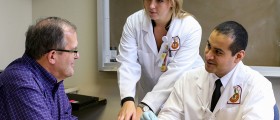
Generally speaking, therapy can be divided into two main branches: occupational therapy and physical therapy.
A (mental) patent who is, (most likely) institutionalized, and is seen eagerly engaged in some constructive activity is the subject of what is commonly known as: occupational therapy. That is to say, the patient is occupied with an activity which is specially designed, and is a part of his/her healing process.
On the other hand, the patient who has recently had a knee replacement, may be seen undertaking a course of seemingly trivial physical exercises. This kind of therapy is called physical therapy, and the exercises are, likewise, specially designed to help him/her reach the point of full recovery as soon as it may be possible.
OT: Occupational Therapy
By definition, occupational therapy is a profession which deals with promoting health and well-being by means of occupation. There is a process which each course of occupational therapy must undergo. It is called the Occupational Therapy Process, and it consists of eleven stages: referral, info gathering, initial assessment, problem identification, goal setting, action planning, ongoing assessment + revision of action, outcome and its measurements, end of intervention and, lastly, review.
Naturally, the physical aspects of occupational therapy are different for those of a child and an adult. The difference is based on the fact that different things keep a child and an adult occupied. Reasons to engagement in OT may be: autism, developmental disorders, fine motor development, as well as emotional/behavioral disturbances or even major traumatic injuries. It may also be used to help elders live healthier lives.
The mental aspects include addressing issues such as: schizophrenia, drug addiction, mood disorders, dementia, anxiety and personality disorders. The methods involved may include trivial chores along the lines of keeping a daily planner, managing money, building social skills, etc.
A community based OT means that the patient is performing these tasks outside of the walls of an institution, and is with people withing the relevant environment.
PT: Physical Therapy
Physical therapy deals with providing measures to treating physical injuries or disabilities. However, all of the following aspects of a person's well-being are also covered: physical, social, psychological and environmental. It normally focuses on a specific body part, circumstance (such as trauma) and a list of motor functions.
There are areas within physical therapy which specialize in resolving a certain type of disability. The varieties include: cardiopulmonary, geriatric, neurological, orthopedic, pediatric as well as integumentary.
Naturally, in order to provide adequate help a somewhat deeper insight in the patient's medical history concerning the particular problem is required.

















Your thoughts on this
Loading...